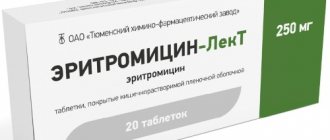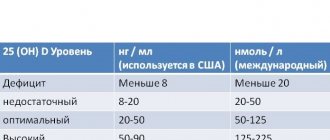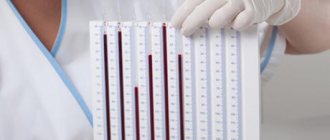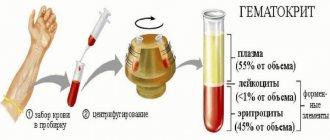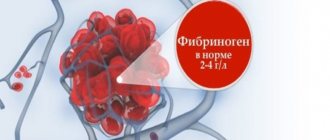Functions and types of cells
Neutrophils are a type of leukocyte - white blood cells that are vital to the immune system. These cells are heterogeneous; in total there are 4 types of neutrophils, which differ in their narrow purpose:
- myelocytes are preneutrophils, maximally immature cells without differentiation, which can eventually turn not only into a neutrophil, but into any blood element: from a platelet to an eosinophil;
- young neutrophils are an immature version of neutrophils, a conditional reserve of cells that begin to work in conditions of the body’s increased need for immune cells; in critical situations, a minimum number of such cells can be recorded in the bloodstream (no more than 1%);
- band neutrophils - make up no more than 5% of the total number of neutrophils, this is already a partially specialized cell of the immune system, it works in the bloodstream if the remaining neutrophils cannot cope with their functions;
- segmented neutrophils are the basis of neutrophil cells; up to 70% of the total number of structures constantly work in the bloodstream; they manifest themselves to the maximum during the infectious and inflammatory process in the body.
Thus, there are only two types of active, that is, capable of acting, neutrophils: segmented and band. They solve the main tasks that the body sets for neutrophils:
- lyse the cell membrane of the pathogen, killing viruses, bacteria, fungi, and other pathogenic microflora;
- enter into an antigen-antibody reaction with microbes, binding pathogenic flora, accelerating the relief of inflammation;
- absorb microbes and digest them (phagocytosis): one cell can destroy up to 30 “strangers”;
- inactivate viruses, reducing the rate of replication of pathogens, helping to stop inflammation of a viral nature.
Neutrophils: what they are, functions, designation, interpretation
Human blood has a complex chemical composition, which includes red blood cells, white blood cells and platelets. The most numerous group is represented by leukocytes. These are white bodies that represent the human immune system.
The leukocyte can be granular (granulocyte) and non-granular (agranulocyte). The granular group is classified by cells: eosinophils, basophils and neutrophils. Neutrophils are microphages. They are responsible for absorbing harmful cells, viruses and bacteria.
Lymphocytes are the main defenders of the human body. Therefore, it is worth understanding what neutrophils are.
Lymphocytes and their functions
Lymphocytes are the main cells of the immune system. They are the ones who come into contact with infectious agents and produce antibodies to them. Lymphocytes in the blood begin to increase in the presence of a pathogen. That is why elevated lymphocytes always indicate problems in the body. Along with lymphocytes, the blood test determines leukocytes, one of whose representatives are neutrophils.
What are neutrophils in the blood for?
The functions of neutrophils are concentrated around one goal - to find and neutralize. Viruses and bacteria attack the human immune system every day. As soon as a harmful cell enters the body, white blood cells receive a signal to act. All their groups rush to this cage. Microphages find the virus, absorb it into themselves, and dissolve it. In this case, they die along with the foreign cell.
This process is called immune defense.
Neutrophils in the blood are “kamikazes”. If we say neutrophils, then these are “suicide bombers”. Neutrophil rods in the blood are necessary to fight viruses that cannot be overcome by other subtypes of leukocytes.
Almost all of them use superficial control methods that destroy the infection membrane. The function of neutrophils is to find infectious molecules against which eosinophils and basophils are powerless.
Because the only way to deal with these molecules is complete absorption and breakdown.
Neutrophil development
The synthesis of this subtype of leukocytes occurs in several stages. Laboratory research is carried out only at the last four stages. Then, based on the deviation from the norm, one can judge the presence of diseases.
Stages of development:
Mature neutrophils at the last stage of development always attack first at the slightest danger. They deactivate the harmful cell and die themselves. This is the primary barrier of the immune system.
Often, microphage defense is sufficient to suppress the disease. But infections are different.
In the case of a dangerous form of a virus or bacteria, after the death of the first batch of “senior” neutrophils, the young defense can enter the battle.
These young neutrophils are able to “finish off” the disease and suppress the remaining harmful cells.
Therefore, the percentage of neutrophils of a particular stage of maturation can be an active indicator for determining the stage and severity of the disease.
To do this, the number of neutrophils in the blood is determined using laboratory tests. Neutrophils are designated as neut. This sign is an international designation.
Deciphering a blood test will not be difficult if you know the corridors of normal values.
Neutrophil norm
What is the neutrophil count in the blood? Neutrophils in a blood test have the same norm for men and women. The test result may vary depending on the age of the patient.
The absolute content of neutrophils is determined by a general biochemical blood test. They may be designated as neut abs. Separate laboratory tests are carried out to determine rods, or young cells, in a blood test.
The function of young neutrophils is to attack first, and older cells follow them into battle.
In a general blood test, neutrophils are divided by age group, the indicator is indicated as a percentage of the total number of leukocytes. The following is considered normal in the blood:
- In adults, these cells should be 45%-70%
- In children in the first year of life 30%-50%
- In children from 1 to 7 years old 35-55%
- In children from 7 to 12 years old 40%-60%
The nuclear composition of microphages may differ in granularity. In addition to the absolute indicator, neutrophils are taken for a general blood test. This study helps answer the question: is the bacillus found in the blood?
Why is there an elevated level?
High neutrophils, what are they? If neutrophils in the blood have a high rate, this means that the body has activated the immune system. An inflammatory process develops, and the intervention of leukocytes is required.
It is very important to take a blood test for neutrophils at the early stage of the disease, when their number is especially high.
Toxogenic granularity of neutrophils is a mutation of the nucleus and cytoplasm of cells, meaning the development of abnormalities. It develops when the body is exposed to harmful environmental factors:
- Dangerous infectious background
- Radiation
- Chemical attack
- Unfavorable external environment
This phenomenon is especially pronounced with the development of dangerous pathologies:
- Acute pneumonia in severe stage
- Peritonitis
- Scarlet fever
- Phlegoma
When the level of white blood cells increases, a condition of neutrophilia occurs, which is otherwise called neutrophilic inflammation.
Why is there a low level?
If the test results in low neutrophils, this phenomenon is called neutropenia or agranulocytosis. When there are too few defenders in the blood, the body cannot cope with viral and bacterial attacks. How then to answer them? Only using external immunostimulants.
Sometimes tests show fewer neutrophils due to taking antiviral drugs. When the course of treatment is completed, all biochemical blood parameters return to normal. Chemotherapy also provokes the development of agranulocytosis.
There is no need to worry if the indicators are reduced quite a bit. The patient's diet greatly influences its level.
Doctors believe that lack of food, or eating foods low in vitamins and folic acid, leads to the development of neutropenia.
If the neutrophil background has been decreasing for a long time, this may indicate the presence of the following diseases:
- Acute viral infections (varieties of influenza, measles, rubella)
- Bacterial diseases (typhoid, brucellosis)
- Protozoal infections (malaria)
- Oncological neoplasms in the hematopoietic organs
- Anemia
- Various forms of leukemia
Taking medications provokes changes in test results. Let's count how many medications we use per year? Probably each of us takes pills without even knowing that drugs containing analgesics and cyostatics significantly reduce the level of leukocytes. Antibacterial drugs that contain interferon have a negative effect on natural immunity.
Recommendations for analysis deviations from the norm
First of all, the doctor will determine the reasons that led to an increased or decreased level of leukocytes. Whether this disease is chronic or its acute form, possibly external factors.
All this will influence the diagnosis and prescription of the correct course of treatment.
Depending on other symptoms characteristic of pathologies, the doctor determines how much level correction is generally necessary. Perhaps it is simply necessary to eliminate the provoking factor, and the biochemistry will recover on its own. In any case, a bad test is usually reviewed by three specialists: a general practitioner, an infectious disease specialist and a hematologist.
Here are a few measures that can be applied, without special instructions from your doctor:
- Quit smoking completely, or for a while
- Review your diet; you may need to add a number of foods.
- Start taking vitamins. Usually in a pharmacy you can easily pick up a ready-made complex with the daily requirement of vitamins.
- Follow the rules of hygiene - wash your hands, use disposable towels.
- Sanitate the oral and nasal cavities. Plain water or special seawater-based sprays will help with this.
- Monitor the condition of food products and process them thoroughly before eating.
A healthy lifestyle is the key to strong immunity and normal biochemical blood parameters! Never neglect getting your blood tested, and you will be able to take control of your health. Remember that timely treatment of any disease is a guarantee of successful and complete healing. It is necessary to undergo a preventive examination at least once a year!
Source: https://krov.expert/analiz/obshhij/nejtrofily-eto.html
Norms of neutrophils in the blood in adults and children
Neutrophils are abbreviated Neut and are counted as a percentage or absolute neutrophil count in units per liter of blood. The choice depends on the laboratory in which the analysis is performed. The norms of neutrophils in men, women, and children are presented in the tables.
In women, the variability of indicators is quite high, correlates with age, depends on hormonal fluctuations: puberty (especially delayed), menstruation, pregnancy. The data may decrease slightly depending on the patient’s condition when the test is taken, but never increase.
On average, the norm of neutrophils in the blood of women is up to 60%. This is slightly higher than that of men, which is explained by the physiological and immune characteristics of the female body.
| Woman's age | Norm in % (according to segmented form) |
| Up to 18 and from 45 to 60 | 50-55 |
| Until 21 | 51,5-56,5 |
| Before 35 and after 60 | 52-60 |
| Up to 45 | 50-58,5 |
In men, normal levels of neutrophils in the bloodstream are not significantly lower: up to 57%, and are correlated with the age and condition of the patient when the test was taken.
| Man's age | Norm in % (according to segmented form) |
| Up to 18 and from 35 to 45 | 50-54 |
| Under 21 and over 60 | 50-56 |
| Up to 35 | 51,5-57 |
| 45-60 | 49-53 |
In children, the calculation of the norm of neutrophils in the blood is carried out by day, month, year, since fluctuations are the most variable. A sharp increase in the first days of life is associated with the active formation of immunity and adaptation to the external environment.
| Child's age | Norm in % (according to segmented form) |
| Newborn | 59-60 |
| 12 hours | 65,1-68,1 |
| 1st day | 60,1-61,1 |
| 7 days | 39,9-42,9 |
| 14 days | 39,1-40,5 |
| 30 days | 35,5-38,2 |
| 6 months | 30,1-32,1 |
| 1 year | 30,5-31,5 |
| 2 years | 30,3-33,5 |
| 4 years | 40,1-42,5 |
| 6 years | 49,1-51,1 |
| 8 years | 50,5-53,1 |
| 10 years | 50,1-54,1 |
| 11-18 years old | 52,5-55,5 |
When and how the analysis is carried out
A blood test for neutrophils is necessary when an adult develops unexplained symptoms:
- anemia in any form;
- signs of poisoning with heavy metals and poisons;
- aching pain localized in joints, bones, muscles;
- fainting, dizziness;
- loss of balance;
- skin rash;
- drowsy state;
- sudden weight loss;
- regular increase in body temperature;
- long-term depression, which is accompanied by aggressiveness;
- increased heart rate;
- hematomas that appear without mechanical impact;
- difficulty swallowing;
- enlarged lymph nodes;
- change in urine color;
- constant thirst.
Important information: Norm of lymphocytes in the blood of children (table by age)
A general blood test for neutrophils is necessary if a person’s cuts and scratches do not heal for a long time. Neutrophils in a general blood test can detect inflammatory diseases or tissue necrosis.
NEUT in a blood test is checked in patients during the postoperative period to monitor their condition.
The analysis is carried out in the morning on an empty stomach; before visiting the clinic you should refrain from:
- physical activity;
- eating fried and fatty foods;
- smoking;
- alcohol.
Blood is taken from a finger or vein.
Pathological causes of growth
The norm of neutrophils in the blood changes in most cases due to pathological reasons, the main of which are:
- inflammation of infectious or autoimmune origin;
- endocrine pathologies;
- tumor growth, metastasis;
- physician error during surgery (iatrogenic factor).
There is an exception to the rule: neutrophils can remain normal against the background of a manifest pathological process, which indicates depletion of the immune system and requires immediate adequate treatment.
Segmented neutrophils are increased
What does it mean? Changes in blood composition may indicate:
- the existence of tumors, leg diseases;
- development of infections (spirochetosis, mycosis, tick-borne encephalitis);
- nephropathy and dysfunction of the urinary system;
- processes of inflammation in gout, arthritis, rheumatism, pancreatitis, tissue damage.
When segmented cells in the blood are elevated, this may indicate the presence of an acute infectious disease in the body, the presence of a malignant tumor or intoxication, which is characterized by the accumulation of microbes and the products of their activity.
Reasons for the downgrade
A decrease in the number of neutrophils in the blood compared to the norm is called a shift in the leukocyte formula to the left. There are several reasons for this condition:
- HIV;
- aplastic anemia;
- severe infections;
- the period after a serious illness, prolonged fasting, cachexia;
- alcoholism;
- hepatitis;
- sepsis;
- radiation sickness;
- intoxication of various etiologies, taking medications (antibiotics, antiviral anti-inflammatory drugs, drugs for the treatment of hyperthyroidism, for chemotherapy);
- deficiency of minerals, B vitamins;
- bone marrow damage;
- enlarged spleen;
- metastasis of cancer of any location to the bone marrow or myeloproliferative processes;
- genetic predisposition;
- hyperglycemia;
- idiosyncrasy, when the reason for the decrease in the concentration of neutrophils in the bloodstream is unclear.
Normal neutrophil count
The healthy range for neutrophils is about 1.5 – 8 x 10*9/L, or 1500 – 8000 cells/microliter. Normal neutrophil levels are usually between 2500 and 7500 neutrophils per microliter. () Neutrophils may normally be slightly higher during pregnancy. ()
The number and proportion of white blood cells in the bloodstream change with time of day, age and other events, such as pregnancy. Although the normal range varies slightly between laboratories, commonly used normal ranges indicate the neutrophil count:
- Newborn baby : 13,000 – 38,000 cells/microliter
- Baby 2 weeks of age : 5,000 – 20,000 cells/microliter
- Adult : 4,500 – 11,000 cells/microliter
- Pregnant woman (third trimester): 5,800 – 13,200 cells/microliter
When in adults (women without pregnancy) the number of white blood cells in the blood exceeds 11,000 cells/microliter (or 11 x 10*9 /l), it is called leukocytosis , which is an increased level of white blood cells. Neutrophilic leukocytosis occurs when a person has more than 7,000 mature neutrophils in a microliter of their bloodstream.
Neutropenia
A neutrophil level of less than 1500 cells/microliter is called neutropenia , although the degree of reduction is important. The number of neutrophils is less than 1000 units. is the most serious condition and may carry serious risks of developing infections. ()
Neutropenia Levels:
- Mild neutropenia: 1,000 – 1,500 cells/microliter or 1.0 – 1.5 x 10*9/l
- Moderate neutropenia: 500 – 999 cells/microliter
- Severe neutropenia: 200 – 499 cells/microliter
- Very severe neutropenia: below 200 cells/microliter
Minor changes in the level of neutrophils or white blood cells are usually not a cause for concern as long as they are temporary. An elevated white blood cell count often means the body is responding to infection, injury, or psychological stress.
Appearance of neutrophils
The appearance of neutrophils, or their “morphology,” can also be useful in diagnosing diseases. While a complete blood count determines the number of white blood cells, a peripheral blood smear for morphology is often done to see specific characteristics that may be present in neutrophils. For example, toxic granulations can be observed in neutrophils during serious infections, hypersegmented neutrophils (more than 5 lobes) can be observed in vitamin B12 deficiency or folate deficiency, etc.
The mechanisms of neutrophil attack during inflammation have been studied. In activated neutrophils, the main mechanisms responsible for inflammation are respiratory burst, degranulation and the formation of neutrophil extracellular traps (nets). During the respiratory burst, neutrophils use oxygen to produce reactive oxygen species (ROS) such as superoxide (O-2), peroxide H2O2, or hypochlorous acid (HOCl) by activating NADPH oxidase (NOX2) and myeloperoxidase (MPO). (source)
Immature neutrophils in the blood
Most of the neutrophils in our blood are mature neutrophils. Immature neutrophils may be found on a blood smear if the body is under stress and there is a strong need for more neutrophils. When this occurs, increased numbers of immature neutrophils may enter the blood from the bone marrow before reaching maturity.
Additionally, increased production of immature neutrophils can occur in conditions such as myelodysplastic syndromes and leukemias , such as acute promyelocytic leukemia. (12)
Reasons for the increase in some cells and the decrease in others
An increase or decrease in neutrophil levels in the blood can be correlated with many factors of natural and pathological origin. There are many uniform elements that are called upon to fight “strangers” in this case. There are two options:
- if neutrophils are elevated, and lymphocytes, on the contrary, this is the first phase of the immune reaction, when central immunity is not yet active enough, and there is no need for it: fluctuations are insignificant;
- if neutrophils are reduced, and lymphocytes, on the contrary, this is the second phase of the immune response, when central cells work more actively, and local-level structures reduce their intensity for a short time.
The general rule is one: when neutrophils increase, lymphocytes decrease and vice versa. This is the norm. There is no simultaneous increase or decrease observed.
general characteristics
Band neutrophils are part of leukocytes. The leukocyte group is a collection of white blood cells. The role of leukocytes is extremely important. It is these cells that go out to fight dangerous bacteria and infections that threaten the body every day.
By looking at the white blood cell count in a person’s blood, one can understand the picture of his immune system. Using this data, a specialist can easily make a correct diagnosis.
When the patient receives the test results, it is difficult for him to understand the meaning of the indicators on the form. What data should he pay attention to first and what should he be afraid of? You need to understand the parameters that can be detected in the results of a blood test.
The normal indicator for a healthy person is a value of 6–7% of the total leukocyte count. Deviations indicate certain problems in the body.
Neutrophils, members of the group of leukocytes, protect the human body by breaking down harmful substances. During this process, neutrophils die. In their place, new ones are formed . Before a neutrophil becomes an independent particle capable of defending the body, it must go through several important stages of development:
- Myeloblast.
- Promyelocyte.
- Metamyelocyte.
- Rod cell.
- Segmented cell.
It is the segmented cell that is independent and complete. It is able to move freely in the blood and has a segmental nucleus.
The rod cell is not yet ready to become an independent element. It appears in the body by injection. And this happens when a threat appears in the form of infections and harmful bacteria.
Special cases of decreased neutrophils
We are talking about genetically determined neutropenia, which is quite rare, but affects the result of a blood test. This:
- benign chronic neutropenia is asymptomatic, there is no danger to life, but when interpreting the analysis, this point is always taken into account;
- cyclic neutropenia occurs in one person per million, does not affect the quality of life, manifests itself in a periodic causeless decrease and then restoration of neutrophils to normal;
- Kostmann's syndrome is a condition when neutrophils are deprived of the opportunity to mature, as a result a person is deprived of natural protection and constantly suffers from all possible infections. Today, provided that the pathology is detected in a timely manner, patients are given courses of drug correction.
What causes an increase in these elements in children?
In childhood, a larger number of band neutrophils is allowed within normal limits. However, going beyond the boundaries of the norm in a child can be provoked by:
- helminthic infestations, especially enterobiasis and ascariasis;
- vaccination;
- acute intestinal diseases;
- pneumonia;
- chronic tonsillitis and adenoids;
- polyps in the nasal cavity;
- period of teething;
- lactose intolerance and other forms of food allergies.
Correction
Treatment is correlated with the underlying cause. The goal is to eliminate the source of the problem. Medicines used include: antibiotics, leukocyte synthesis stimulators (Granulocyte-colony-stimulating factor or Granulocyte-macrophage colony-stimulating factor), local antiseptics. For autoimmune reactions - hormones and immunosuppressants. Diabetes mellitus requires control of glucose levels, tumors require surgical intervention. Otherwise, therapy is symptomatic.
Treatment of abnormalities
To date, there is no specific treatment for neutrophilia and neutropenia. The fact is that in medicine, not a single doctor is engaged in “treating tests.” When a deviation is detected, it is very important to identify its root cause, and only then choose treatment tactics.
During the first visit, the doctor asks the patient in detail about possible complaints, clarifies past diseases, and conducts an examination. Often at this stage it is possible to find out the reasons for deviations in the blood test.
Next, according to indications, a series of laboratory and instrumental research methods are carried out: detailed blood tests, urine tests, radiography, ultrasound, computed tomography, etc. You may also need to consult a specialist (ENT specialist, hematologist, rheumatologist, etc.).
Depending on the results of the examination, treatment is prescribed : courses of antibacterial and anti-inflammatory therapy, physiotherapy, surgical interventions, correction of basic therapy (for example, during exacerbation of chronic obstructive pulmonary disease), correction of glucose-lowering therapy for diabetes, etc.
Indicator 0
There is an indicator of 0 - what does this mean? Indicator 0 in a child and 0 in an adult can most often be provoked by the following factors:
- Bacterial infections such as typhus, tularemia or chronic brucellosis.
- Viral infections that can lead to a decrease in neutrophils. In such a situation, the patient may become ill with rubella, influenza, scarlet fever, measles, diphtheria or viral hepatitis.
- Toxic effects of medications.
- Anemia can cause a lack of neutrophils in an adult or child.
- Because of radiation.
How to fix the situation
The results of the study show a real picture of the health status of adults and children. Having in hand indicators of the percentage of cells that deviate from established standards, you need to immediately take certain measures.
To achieve normalization of indicators, you do not need to take a course of medications. There is no specific pill for this failure. To correct the situation, you need to find a specific cause, in other words, identify a specific disease and cure it. In this way, harmony can be restored in neutrophil counts.
Often, a prerequisite for changing the balance of cells is long-term use of medications. In this case, the solution is simple: you should stop taking these medications.
An abnormal neutrophil percentage can be caused by a lack of vitamins and minerals in the body. The patient should adhere to a strict diet and take vitamins.
In any case, a healthy lifestyle, proper nutrition, adequate physical activity, and giving up alcohol and smoking will help maintain your health at the desired level.
